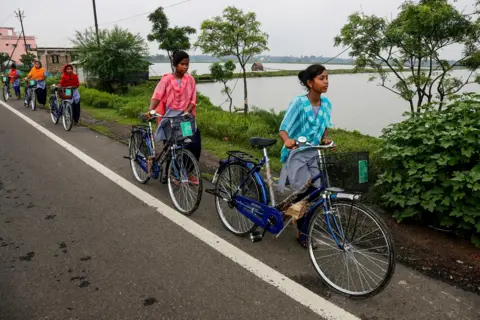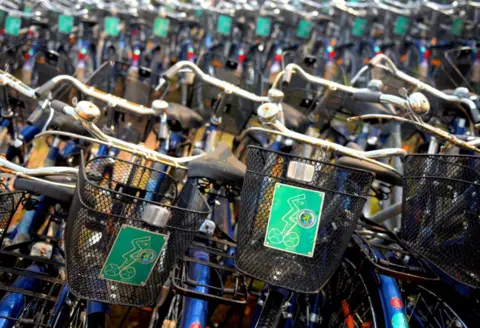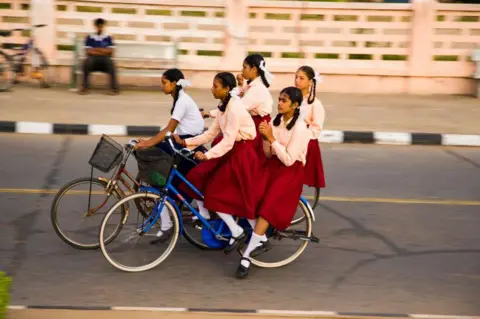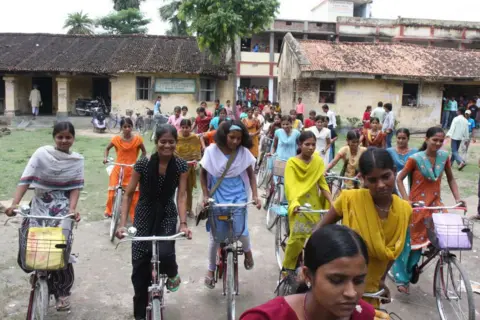Indian schoolgirls are leading a quiet cycling revolution

 AP
APNibha Kumari, a resident of Bihar, India’s poorest state, recalls how a bicycle changed her life when she was 15.
For two years, six days a week, she cycled two hours a day from home to school, to her tutoring class and back on a bicycle provided by the state government.
“Without the bicycle, I don’t think I would have been able to finish high school. It changed my life,” said Nibha, now 27.
The daughter of a farmer in Begusarai district, Nibha was sent to live with her aunt 10km (six miles) away to attend a nearby primary school. Travel was difficult for girls and public transport was unreliable.
When Nibha returned home to attend high school, she hopped on her bicycle and tackled the bumpy village roads to pursue her education.
“Girls have become much more confident after they started using bicycles to go to school and extra classes. More and more of them are coming to school. Most of them get free bicycles,” said Bhuvaneshwari Kumari, a health worker in Begusarai.
 Getty Images
Getty ImagesShe’s Right. A New Peer Review learn Published in the journal ScienceDirect, it reveals remarkable insights into school children and cycling in rural India.
Research by Srishti Agrawal, Adit Seth and Rahul Goel shows that the most notable increase in cycling activity in India has occurred among rural girls – more than doubling from 4.5% in 2007 to 11% in 2017 – narrowing the gender gap in this activity.
“This is a silent revolution. We call it a revolution because of the increased cycling among girls in a country with high levels of gender inequality in women’s mobility outside the home in general and in cycling in particular,” said Ms Agrawal.
Government-run free bicycle distribution programmes since 2004 have targeted girls, who are more likely than boys to drop out of school due to the burden of housework and long walks. This approach is not unique to India – evidence from countries such as Colombia, Kenya, Malawi and Zimbabwe also shows that bicycles are effective in boosting girls’ enrolment and retention in school. But the scale here is unparalleled.
Three researchers – from the Indian Institute of Technology in Delhi and the Narsee Monjee Institute of Management Studies in Mumbai – analysed travel modes for school children aged 5-17 from a nationwide education survey, looked at the effectiveness of state-run programmes that provide free bicycles to students and examined their impact on cycling rates.
 Getty Images
Getty ImagesThey found that nationwide, the proportion of students cycling to school increased from 6.6% in 2007 to 11.2% in 2017.
Cycling to school in rural areas has doubled over the past decade, while in urban areas it has remained stagnant. Indian city roads are notoriously unsafe, with low cycling to school in urban areas linked to poor traffic safety and the high number of cars on the road.
India’s cycling revolution is strongest in the countryside, with states like Bihar, West Bengal, Assam and Chhattisgarh leading the growth. These states have populations comparable to some of Europe’s largest countries. Research shows that cycling is most popular over longer distances in rural areas than in urban areas.
India only began reporting cycling behavior for the first time in its most recent census in 2011. Only 20% of commuters reported cycling as their primary mode of transportation. But people in villages were more likely to cycle (21%) than those in cities (17%).
Additionally, more working men (21.7%) cycle to work than women (4.7%). “Compared to the international context, this gender gap in cycling is one of the highest in the world,” said Agrawal.
 Getty Images
Getty ImagesAmerican women’s suffragist Susan B Anthony once said that the bicycle “has done more for the liberation of women than any other thing in the world. It has given women a sense of freedom and self-reliance.”
Researchers wonder whether women cycle less as they age due to shrinking employment opportunities and job abandonment. Nibha stopped cycling after she got married and moved into her in-laws’ home. Although she still cycled outside the home while training to become a teacher, when asked about her commute, she simply said, “I don’t need to cycle anymore.”





